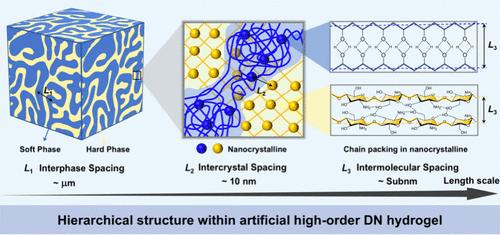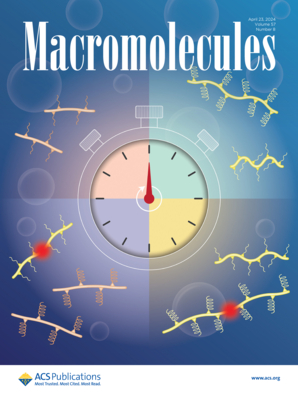A High-Order Double Network Hydrogel
IF 5.1
1区 化学
Q1 POLYMER SCIENCE
引用次数: 0
Abstract
Natural hydrogels, such as cartilage, have a multiscale hierarchical structure composed of multiple modulus-contrasting building blocks, bringing about their extraordinary mechanical properties. Conventional tough engineering hydrogels, such as Double Network (DN) hydrogel, lack cartilage’s high-order aggregated structure across multiple length scales, although they have a molecular composition similar to cartilage. This work focuses on high-order architecture in DN hydrogels through superimposing microphase separation and nanocrystalline domains in interpenetrating molecular networks of stiff chitosan and soft poly(vinyl alcohol) by using freezing-thawing-assisted alkali out. The constructed High-order Double Network (HDN) architecture has a molecular composition identical to initial interpenetrating molecular networks but exhibits hierarchical multiscale discrepancies, including bicontinuous phase at microscale, nanocrystalline domains at nanoscale, and polymer chain packing at subnanoscale. We find that these structural differences are strongly correlated with the macroscopic properties of the hydrogel, such as turbidity, stiffness, strength, and toughness. We reveal the stepwise multiscale fracture mechanism of the HDN architecture that leads to a highly synergistic toughening effect. The HDN hydrogel also exhibits excellent multifunctional properties, including antiswelling, durability, biocompatibility, antibacterial activity, degradability, and plasticity. We believe that the high-order architecture presented in this work would shed new light on the future development of high-performance DN hydrogels that approximate natural hydrogels.

高阶双网络水凝胶
天然水凝胶(如软骨)具有多尺度分层结构,由多个模量相反的构建模块组成,因而具有非凡的机械性能。传统的韧性工程水凝胶,如双网络(DN)水凝胶,虽然分子组成与软骨相似,但缺乏软骨在多个长度尺度上的高阶聚集结构。这项研究的重点是通过冷冻-解冻辅助碱出法,在坚硬的壳聚糖和柔软的聚乙烯醇相互渗透的分子网络中叠加微相分离和纳米结晶畴,从而研究 DN 水凝胶的高阶结构。所构建的高阶双网络(HDN)结构的分子组成与初始互穿分子网络相同,但表现出分层多尺度差异,包括微尺度的双连续相、纳米尺度的纳米晶域和亚纳米尺度的聚合物链堆积。我们发现,这些结构差异与水凝胶的宏观特性(如浊度、硬度、强度和韧性)密切相关。我们揭示了 HDN 结构的分步多尺度断裂机制,该机制可产生高度协同的增韧效果。HDN 水凝胶还表现出卓越的多功能特性,包括抗溶胀性、耐久性、生物相容性、抗菌活性、可降解性和可塑性。我们相信,这项工作中提出的高阶结构将为未来开发近似天然水凝胶的高性能 DN 水凝胶带来新的启示。
本文章由计算机程序翻译,如有差异,请以英文原文为准。
求助全文
约1分钟内获得全文
求助全文
来源期刊

Macromolecules
工程技术-高分子科学
CiteScore
9.30
自引率
16.40%
发文量
942
审稿时长
2 months
期刊介绍:
Macromolecules publishes original, fundamental, and impactful research on all aspects of polymer science. Topics of interest include synthesis (e.g., controlled polymerizations, polymerization catalysis, post polymerization modification, new monomer structures and polymer architectures, and polymerization mechanisms/kinetics analysis); phase behavior, thermodynamics, dynamic, and ordering/disordering phenomena (e.g., self-assembly, gelation, crystallization, solution/melt/solid-state characteristics); structure and properties (e.g., mechanical and rheological properties, surface/interfacial characteristics, electronic and transport properties); new state of the art characterization (e.g., spectroscopy, scattering, microscopy, rheology), simulation (e.g., Monte Carlo, molecular dynamics, multi-scale/coarse-grained modeling), and theoretical methods. Renewable/sustainable polymers, polymer networks, responsive polymers, electro-, magneto- and opto-active macromolecules, inorganic polymers, charge-transporting polymers (ion-containing, semiconducting, and conducting), nanostructured polymers, and polymer composites are also of interest. Typical papers published in Macromolecules showcase important and innovative concepts, experimental methods/observations, and theoretical/computational approaches that demonstrate a fundamental advance in the understanding of polymers.
 求助内容:
求助内容: 应助结果提醒方式:
应助结果提醒方式:


